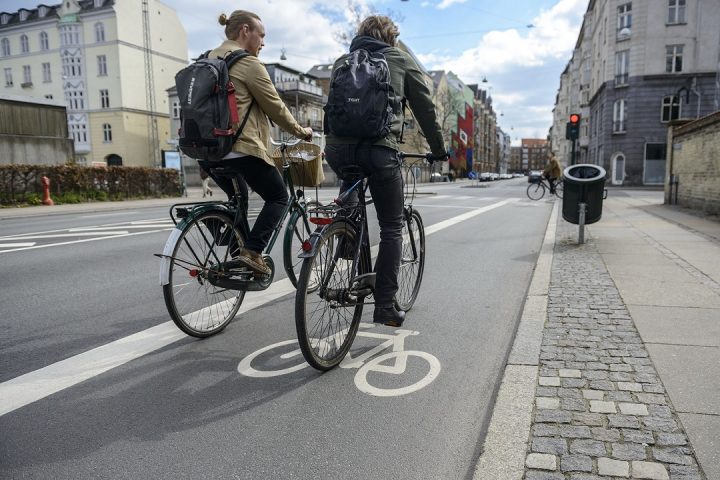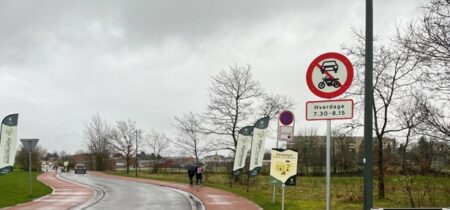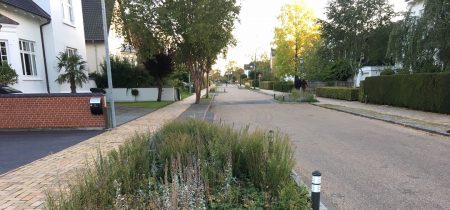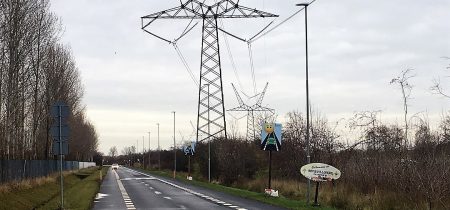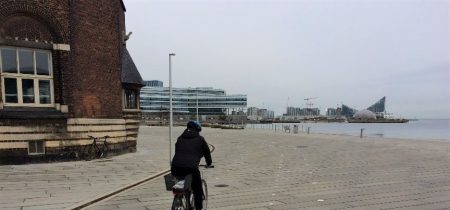Cycle lanes
Cycle lanes are a cheaper alternative to cycle tracks, but have a smaller positive effect. The cross profile must be sufficiently wide, and it’s important to choose the correct solution for parking, and especially for bus stops.
By Troels Andersen, Odense Municipality
Cycle lanes are primarily used in urban areas. Cycle lanes can be a good alternative to cycle tracks when space and funding make it difficult to establish cycle tracks. Cycle lanes can also serve as a transition solution before establishing cycle tracks with kerbs.
Cycle lanes are a much more common solution in other countries than in Denmark when local authorities wish to make cycling areas visible over a larger area with the funds that are currently available. In Denmark the preferred solution is what we call a proper cycle track.
Wide cycle lanes result in a big drop in accidents on road stretches, but may pose safety issues at intersections. Three different studies show that the number of cycling accidents increases by 10% when cycle lanes are installed in urban areas. The increase in the total number of accidents covers a significant drop on road stretches and a significant increase at intersections.

- Cycle lanes can be a forerunner for a proper cycle track, which is both more secure and safer for children and the elderly. Photo Troels Andersen
A Copenhagen study shows a 5% increase in the number of accidents on road stretches and at intersections, and a 15% increase in the number of personal injuries. During the same period bicycle/scooter traffic rose by 5-7%, while motor traffic remained constant.
Studies indicate that road stretch accidents in connection with parked cars do not disappear when cycle lanes are installed. Passing accidents, when cars run into cyclists from behind, still occur when cycle lanes are too narrow.
Left turning cars are a major issue on roads with cycle lanes. The most serious intersection accidents occur with left turning cyclists.
There are many indications that mini- roundabouts, cycle crossings, and speed limit reduction are measures that eliminate some intersection accidents on roads with cycle lanes.
Danish traffic counts show that installing a cycle lane on only one road has a minimal effect on the number of cyclists (an increase of 0-5%). If, however, an entire network of cycle lanes is established in an urban area without prior cycle tracks, the number of cyclists will increase. This is also the experience of New York, Sydney, and Seville where the cycling infrastructure is primarily based on cycle lanes. Cyclists feel safer and perceive cycle lanes as a definite improvement of the service level compared to mixed traffic.

- Uncomfortable, dangerous, and unlit – there’s room for improvement here.
Establishing cycle lanes
A cycle lane is marked on the traffic lane with a 0.3 wide edge line and bicycle symbols at intervals of approx. 100 meters, and every time the edge line is interrupted (after intersections). The bicycle symbol may be replaced with a D21 cycle track sign at intersections. The cycle lane is established for one-way bicycle traffic on either side of the road. Cars are not allowed to park in the cycle lane, they must park in the traffic lane outside the cycle lane (unless parking is prohibited.)
Cross profile
Cycle lanes should be min. 1.5 m wide incl. a 0.3 m edge line. If the lane is narrower than 1.5 m, cyclists passing each other often use the traffic lane. Acceptable passing conditions require a width of 1.7 m. The edge line must be solid, but may have a raised surface to sharpen road users’ attention. Thermoplastic is a good material for marking due to its excellent visibility, durability, friction and cost.
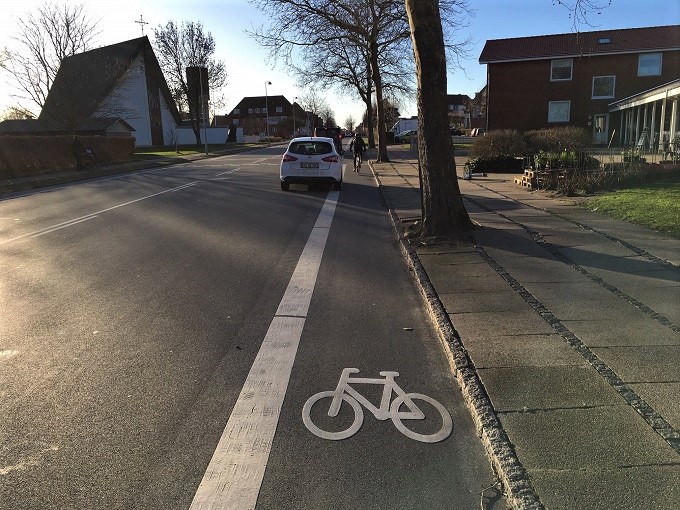
- Cycle lanes in combination with speed bumps can provide an acceptable level of security and safety for most cyclists. Photo Troels Andersen
Cycle lanes can be installed in different colours (for example red or brown) to emphasize cycle route cohesion and clarify the traffic area’s use. The coloured surface can be continued through crossings marked as a cycling area with wide, dotted lines and the bicycle symbol. However no documentation is available about the effect of coloured surfaces.
Coloured surfaces mean fewer disturbances of bicycle traffic from cars, and cyclist perception of coloured surfaces is positive. When cycle lanes are wider than 1.8 m a coloured surface is important since the cycle lane may otherwise be confused with a parking or traffic lane. The safety effect of coloured cycle lanes has not been documented.
Maintenance of the coloured surface is important because otherwise it becomes very unattractive. Thermoplastic loses colour over time and black asphalt used to reinstate the surface after excavations makes for an extremely ugly surface.
Several studies indicate that narrow cycle lanes are worse from the traffic safety point of view than stretches with mixed traffic. When cycle lane width is increased the distance between the cyclist and the car is greater and the number of cyclists who dart out onto the traffic lane falls.
Parking
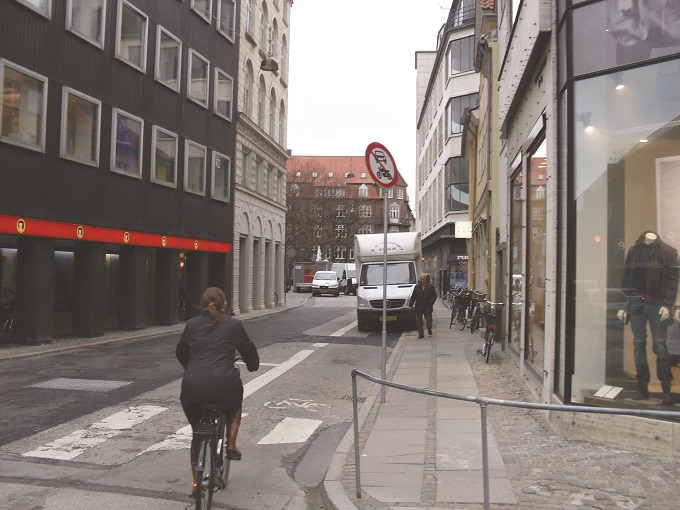
- Cycle lanes are often used for illegal parking and especially for deliveries if no other options are available. Photo Troels Andersen
Parking should be prohibited on roads with cycle lanes in areas where parked cars are continually circulating in and out (for example on shopping roads or where there are blocks of flats). Parking facilities should always be designed so the space can only be used for parking, not as an extra traffic lane during peak hours.
When there is parking between the cycle lane and the traffic lane, a 2-2.5 m wide cycle lane enables cyclists to pass each other safely and makes it easier for cyclists to manoeuver around pedestrians and opening car doors. A 1.0 m wide traffic island or painted median between the cycle lane and the parking area should be established whenever possible. Otherwise it may be a good idea to place edge lines outside the cycle lane. If the distance between the traffic islands is small, the cycle lane can be considered a cycle track. Signage or bicycle symbols should be used to clarify the use of the traffic area.
If there is parking between the cycle lane and the pavement the parking lane should be wide enough (preferably 2.5 m minimum) so drivers don’t open the car door onto the cycle lane. On the other hand the cycle lane needn’t be wider than normal. The edge line should be dotted. Frederiksberg municipality is testing this solution. It’s generally better for cars to park outside the cycle lane.
The only type of parking that is acceptable on roads with cycle lanes is parallel parking. Angled and perpendicular parking increase the risk of accidents so significantly that this type of parking is only acceptable in car parks and minor local roads where cycle lanes are unnecessary. And even there they constitute a safety risk, especially for cycling children.
Bus stops
Depending on the amount of space available at bus stops, planners can either establish a bus bulb, a short cycle track, or a bus platform between the cycle lane and the traffic lane so bus passengers don’t need to negotiate a high step getting on and off the bus.
The edge lane outside the bus bulb is marked with two wide, dotted edge lines and extra cycle symbols. If the bus platform is placed at the edge of the traffic lane, other traffic has to wait behind the bus.
In Aalborg a system has been designed combining cycle lanes on road stretches with cycle tracks at bus stops, parking bays, crossings, etc. to forestall conflicts and enhance accessibility.
Sources
Nielsen, Erling Dan, Andersen, Karina Vestergaard og Lei, Karen Marie (1996): Trafiksikkerhedseffekten af cykelbaner i byområder, Rapport 50, Vejdirektoratet, Danmark.
Smith, Robert L. og Walsh, Thomas (1988): Safety Impacts of Bicycle Lanes, Transportation Research Record 1168, USA.
Ágústsson, Lárus og Lei, Karen Marie (1994): Trafiksikkerhedseffekten af cykelbaner på strækninger mellem kryds i byområder, Notat 12, Vejdirektoratet, Danmark.
Nielsen, Erling Dan, Andersen, Karina Vestergaard og Lei, Karen Marie (1996): Trafiksikkerhedseffekten af cykelbaner i byområder, Rapport 50, Vejdirektoratet, Danmark.
Søren Underlien Jensen, Trafitec (2006): Effekter af cykelstier og cykelbaner.
Landis, Bruce W.; Vattikuti, Venkat R. og Brannick, Michael T. (1996): Real-Time Human Perceptions – Toward a Bicycle Level of Service, Transportation Research Record 1578, USA.
CROW (1998): Recommendations for traffic provisions in built-up areas, Record 15, Holland.
Giæver, Terje; Øvstedal, Liv og Lindland, Terje (1998): Utforming av sykkelanlegg – intervju og atferdsundersøkelser, Rapport STF22 A97615, SINTEF, Norge.
Herrstedt, Lene; Nielsen, Michael Aakjer; Ágústsson, Lárus; Krogsgaard, Karen Marie Lei; Jørgensen, Else og Jørgensen, N.O. (1994): Cyklisters sikkerhed i byer, Rapport 10, Vejdirektoratet, Danmark.


